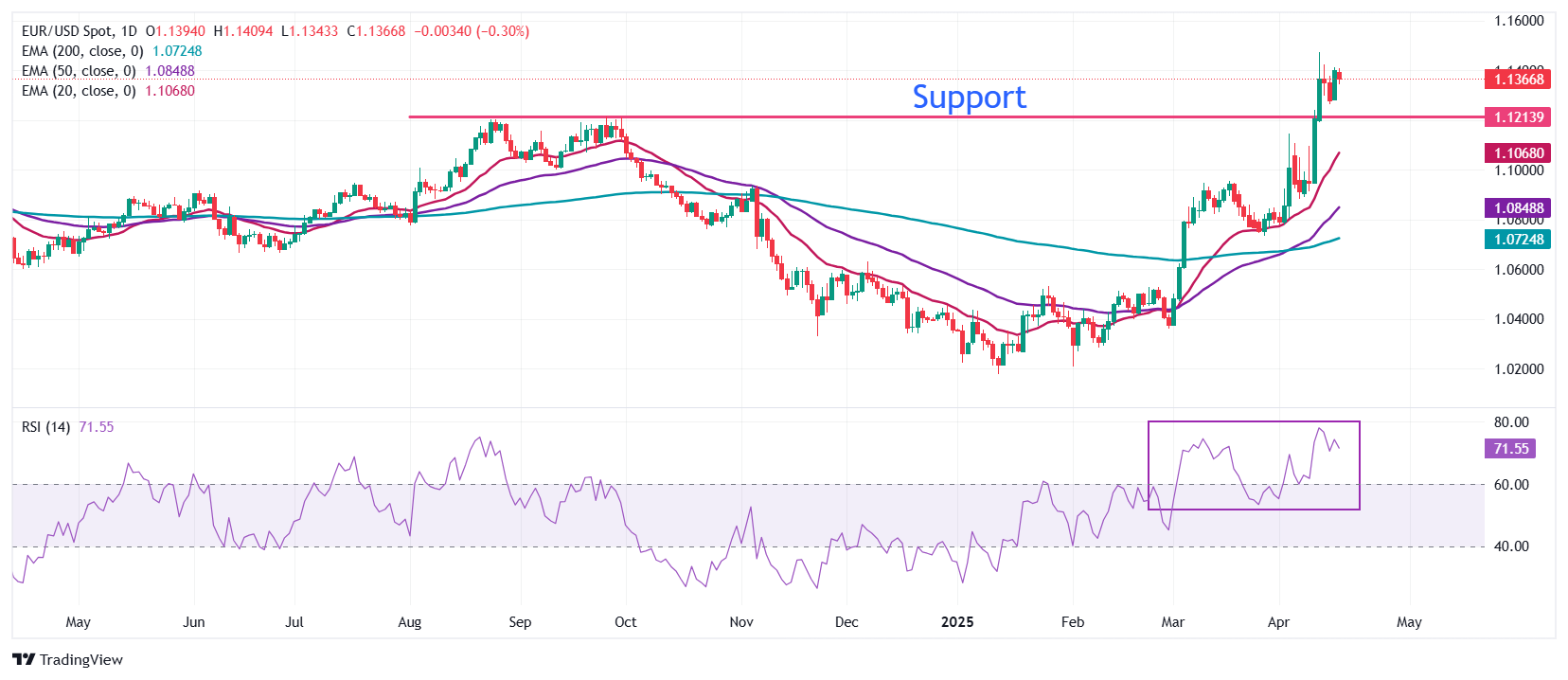- EUR/USD falls to about 1,1350 before the ECB monetary policy meeting.
- The ECB is expected to cut interest rates at 25 basic points for the sixth consecutive time.
- The great progress in commercial conversations between the US and Japan has provided some relief to the US dollar.
EUR/USD decreases to about 1,1350 during Thursday’s European negotiation hours. The main currency pair moves down before the decision on the interest rates of the European Central Bank (ECB), which will be announced at 12:15 GMT. It is widely anticipated that the ECB cuts its key interest rates in 25 basic points (BPS), carrying the deposit rate and the main refinancing operations rate at 2.25% and 2.4%, respectively.
The operators are increasingly sure that the ECB will reduce interest rates for the seventh time since the Central Bank began its relaxation cycle in June and for the sixth consecutive time, in the midst of a high conviction that inflation in the Eurozone is on its way to returning to the goal of the bank of 2% by the end of the year. In addition, the fears of economic shocks in an economy that already slows are paving the way for a greater relaxation of monetary policy.
Since the ECB is almost certain that it will reduce interest rates, investors will pay close attention to the press conference of the ECB president, Christine Lagarde, in search of new clues about monetary policy and economic perspectives. Financial market participants will be interested in knowing whether Lagarde will commit to their position that interest rates remain restrictive. If Lagarde reiterates the same, the probability of a greater relaxation of the policy this year will increase.
In addition to that, investors would like to know how much the tariff policy of the president of the United States (USA), Donald Trump, in the economic growth of the Eurozone and what kind of measures will take the ECB to contain it.
The old continent is expected to be one of the main victims of Trump’s international policies, even when the European Union Trade Commission (EU) can negotiate a fair agreement with Washington. China is expected to diversify its products to other nations if the commercial war between the US and Beijing continues. China could sell many products to the euro zone and other economies, since no other nation can exceed its low -cost competitive advantage.
What moves the market today: Eur/usd falls while the US dollar bounces
- EUR/USD corrects from the round level of 1,1400 while the US dollar (USD) strives to gain ground near its recent minimums. The US dollar index (DXY), which follows the value of the dollar against six main currencies, bounces about 99.60. The dollar attracts offers for positive development in commercial negotiations between the US and Japan.
- On Wednesday, the US president, Trump, indicated through a publication in Truthsocial that negotiations between the Minister of Economic Revitalization of Japan, Ryosei Akazawa, and the US departments have made great progress. “A great honor to have met with the Japanese delegation on trade. Great progress!“Trump wrote.
- Investors see this as a constructive step by Donald Trump that will reduce the fears of global economic agitation. Your preference for negotiating bilateral trade agreements with its commercial partners instead of imposing high tariffs will relieve uncertainty throughout the world.
- However, the commercial war escalated between the US and China will keep investors on alert. The struggle between the two greatest powers in the world has changed “who will begin commercial conversations” to “tariff size”. On Tuesday, the White House Secretary, Karoline Leavitt, said the president is open to a commercial agreement with Beijing, but China should make the first movement. “The ball is on China’s court: China needs to make an agreement with us, we don’t have to make an agreement with them,” Leavitt said, according to Reuters.
- Meanwhile, the fears of increasing inflation and a slower economic growth at the national level will keep the US dollar at a disadvantage. On Wednesday, the president of the Federal Reserve (Fed), Jerome Powell warned that growth has probably “slowed into the first quarter of 2025” since last year’s solid rhythm before Trump’s economic policies. However, Powell was confident that the economy is ‘solid’ despite the greatest uncertainty and downward risks, and reiterated a “wait and see” approach until the Fed obtains greater clarity.
Technical analysis: EUR/USD faces pressure about 1,1400

EUR/USD falls after not being able to extend the recovery above 1,1400 in the European session on Thursday. However, the general perspective of the main currency pair is strongly bullish, since all long -term exponential mobile socks (EMAS) have an ascending slope.
The 14 -day relative force (RSI) index remains above 70.00, indicating a strong bullish impulse.
Looking up, the psychological level of 1,1500 will be the main resistance for the torque. On the contrary, the minimum of April 11, 1,1190 will be the key support for the euros of the euro.
Euro Faqs
The euro is the currency of the 19 countries of the European Union that belong to the Eurozone. It is the second most negotiated currency in the world, behind the US dollar. In 2022, it represented 31 % of all foreign exchange transactions, with an average daily business volume of more than 2.2 billion dollars a day. The EUR/USD is the most negotiated currency pair in the world, with an estimate of 30 %of all transactions, followed by the EUR/JPY (4 %), the EUR/GBP (3 %) and the EUR/AU (2 %).
The European Central Bank (ECB), based in Frankfurt (Germany), is the Eurozone reserve bank. The ECB establishes interest rates and manages monetary policy. The main mandate of the ECB is to maintain price stability, which means controlling inflation or stimulating growth. Its main tool is the rise or decrease in interest rates. Relatively high interest rates (or the expectation of higher types) usually benefit the euro and vice versa. The GOVERNMENT BOOK of the ECB makes decisions about monetary policy in meetings that are held eight times a year. The decisions are made by the directors of the National Banks of the Eurozone and six permanent members, including the president of the ECB, Christine Lagarde.
Eurozone inflation data, measured by the harmonized consumer prices index (IPCA), are an important economic indicator for the euro. If inflation increases more than expected, especially if it exceeds 2% of the ECB, it forces the ECB to rise interest rates to control it again. Relatively high interest rates compared to their counterparts usually benefit the euro, since they make the region more attractive as a place for global investors to deposit their money.
Published data measure the health of the economy and can have an impact on the euro. Indicators such as GDP, manufacturing and services PMIs, employment and consumer trust surveys can influence the direction of the single currency. A strong economy is good for the euro. Not only attracts more foreign investment, but it can encourage the ECB to raise interest rates, which will directly strengthen the euro. Otherwise, if economic data is weak, the euro is likely to fall. The economic data of the four largest economies in the euro zone (Germany, France, Italy and Spain) are especially significant, since they represent 75% of the economy of the euro area.
Another important fact that is published on the euro is the commercial balance. This indicator measures the difference between what a country earns with its exports and what you spend on imports during a given period. If a country produces highly demanded export products, its currency will gain value simply by the additional demand created by foreign buyers seeking to buy those goods. Therefore, a positive net trade balance strengthens a currency and vice versa in the case of a negative balance
Source: Fx Street
I am Joshua Winder, a senior-level journalist and editor at World Stock Market. I specialize in covering news related to the stock market and economic trends. With more than 8 years of experience in this field, I have become an expert in financial reporting.







